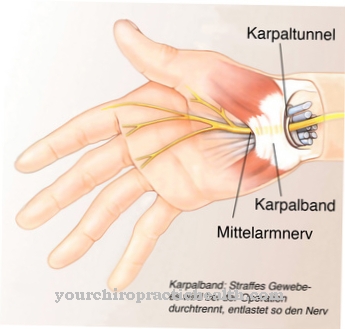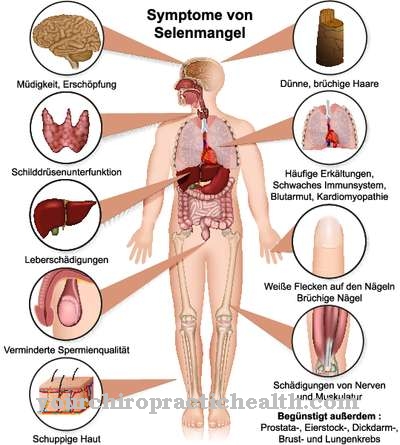The Maple syrup disease is a rare autosomal recessive inherited enzyme defect that leads to breakdowns in certain branched-chain amino acids. With early diagnosis and therapy, the affected children show a largely normal development.
What is maple syrup disease?

As a maple syrup disease (also: Leucinosis or Maple Syrup Urine Disease) is a genetic metabolic disorder in the breakdown of the three branched-chain amino acids leucine, isoleucine and valine, which is inherited via the autosomal recessive inheritance.
As a result of the defect, these three amino acids accumulate increasingly in the body fluids and cause the symptoms characteristic of maple syrup disease such as poor drinking in newborns, vomiting, disturbed muscle activity (muscle hypotonia, opisthotonus), breathing disorders (metabolic encephalopathy) as well as seizures and coma.
In addition to the common classic form of maple syrup disease, other forms are differentiated depending on the severity of the metabolic disorder and the resulting enzyme activity. In the case of the intermediate variant, the symptoms only manifest themselves in infancy and in a weakened form.
The so-called intermittent form of maple syrup disease develops symptomatically, especially in the case of intercurrent infections (with fever, diarrhea or vomiting), operations or as a result of excessive protein intake from food.
causes
Maple syrup disease is inherited in an autosomal recessive manner and is caused by various defects in the so-called branched-chain alpha-keto acid dehydrogenase complex, a multi-enzyme complex.
As a result of these defects, there is a deficiency or reduced activity of this multi-enzyme complex, which causes a breakdown of the amino acids leucine, isoleucine and valine. As a result, these and their corresponding alpha-keto acids accumulate in the body tissue and in the body fluids such as blood and urine of the person concerned and lead to pronounced neurological symptoms.
It is also characterized by a sweetish body and urine odor reminiscent of maple syrup and for which the substance compound sotolon (the most important odor component in lovage and fenugreek), which is synthesized in the isoleucine intermediate metabolism, is responsible.
Symptoms, ailments & signs
Children with maple syrup disease refuse to eat. This leads to weight loss relatively quickly, which is noticeable through mental deficits and physical symptoms such as sunken eye sockets. Externally, the disease also shows itself through muscle stiffness and cramps.
Affected infants also experience nausea and vomiting. Many children scream or appear listless. This apathy increases as the disease progresses and can indicate severe maple syrup disease. However, the most characteristic symptom is the sweetish smell of the urine. The odor of urine is reminiscent of maple syrup, which is due to the excessive sugar content in the urine.
Furthermore, the disease leads to drinking weakness. Dehydration occurs, which can be recognized by the leathery skin, the sunken face and other external signs. Typical symptoms of dehydration are tiredness and numbness. Maple syrup disease can also cause what is known as opisthotonus, a spasm in the extensor muscles of the back that is accompanied by severe pain and dysfunction.
The disease is fatal in many cases and is associated with a multitude of complaints that increase in intensity as the disease progresses. Maple syrup disease can usually be clearly diagnosed on the basis of the typical urine smell.
Diagnosis & course
In addition to the symptoms that manifest themselves at different ages depending on the form of the disease, the Maple syrup disease diagnosed on the basis of an increased concentration of the affected amino acids leucine, isoleucine and valine as well as the corresponding alpha-keto acids in blood and urine.
The diagnosis is confirmed by the detection of allo-isoleucine as a specific indicator for maple syrup disease in the serum and urine. In addition, pronounced ketoacidosis (metabolic acidosis) and hypoglycaemia (low blood sugar level) can be identified in the case of maple syrup disease, especially in catabolic crises.
The increased concentrations are generally detected in the context of tandem mass spectrometry, a laboratory test method for determining the mass of the molecules in the serum or urine. With an early diagnosis and timely start of therapy, an almost normal development of the affected child can be made possible in the presence of a maple syrup disease based on current knowledge. If left untreated, maple syrup disease can lead to disorders of mental development and of the cerebrum.
Complications
Maple syrup disease or leucinosis is a genetic metabolic disease or an enzyme defect. This is already evident in infants and young children with corresponding symptoms. As a more common complication, an intermittent form of this disease can be triggered by infection.
Operations or a diet that is too high in protein can also trigger such sequelae. As a result of the increased risks, patients must be closely monitored in all catabolic crises caused by infections, operations or other stressful situations. If necessary, acute treatments with glucose or insulin nutrient solutions must be carried out. Dialysis may also be necessary.
The usual therapy for maple syrup disease aims to stabilize or normalize the measured values of three disease-causing amino acids. The stabilization of the maple syrup disease is achieved through a lifelong diet with a greatly reduced protein content. However, if there are complications in the course of the disease, it may be necessary to carry out a liver transplant in individual cases. To do this, however, there must be other diseases that call into question the achievability of the therapy goals.
Another complication of the disease arises as a result of the prescribed low-protein diet. With the drastic reduction in protein-containing foods, there is a lack of amino acids. These are the most important building blocks of life. However, this complication can be prevented with specialized dietary supplements. It is important that the prescribed amino acid preparations remain free of leucine, isoleucine and valine.
When should you go to the doctor?
The maple syrup disease is a hereditary disease with numerous and serious effects that must be monitored. Professional medical care is essential immediately after the birth, otherwise the baby will die. The disease is usually diagnosed by the typical signs, especially the sweetish urine odor.
For those affected with maple syrup disease, lifelong medical care is essential, depending on the course and severity of the mutation. Only with the thiamine-dependent variant of the "Maple syrup urine disease" is no lifelong low-protein diet necessary to avoid certain proteins. It is a matter of weighing up whether doctors are already considering liver transplants for affected small children.
Above all, there are not enough suitable grafts available. Therefore, the classic treatment with a medically monitored and low-protein diet is the most popular alternative. In addition, other treatment options are usually necessary. These require close-knit and lifelong medical care for leukocynosis patients.
International researchers are currently looking for more suitable and less stressful treatment methods to give those affected by maple syrup disease a better quality of life. Even harmless infections in children must be under medical observation. The optimal balance of branched amino acids is crucial for a life free from crises. With optimal medical care, those affected have a normal life expectancy.
Doctors & therapists in your area
Treatment & Therapy
In the case of maple syrup disease, therapeutic measures aim to stabilize and normalize the concentrations of the branched-chain amino acids through a lifelong diet, the administration of the cofactor thiamine (vitamin B1) or a liver transplant, the latter only being used in very isolated cases and when other diseases are present .
A small proportion of those affected by maple syrup disease respond to high-dose thiamine, which can suppress the symptoms of maple syrup disease over the long term. In addition, a lifelong protein-restrictive (low-protein) diet is indicated in the case of maple syrup disease, in which branched-chain amino acids are avoided in particular.
In order to compensate for the resulting lack of essential amino acids, these have to be supplemented with special leucine, isoleucine and valine-free amino acid mixtures, which are usually enriched with trace elements, vitamins and minerals at the same time. For affected newborns or infants, dietetic products for the bottle are offered, which are prepared with boiled water.
To monitor the success of the therapy, the blood values, especially the leucine concentration, are checked regularly. In addition, those affected by maple syrup disease have to be given acute infusions (glucose, insulin nutrients) and dialysis (blood exchange transfusions) during catabolic crises as a result of infections, operations or other stressful or stressful situations in order to avoid damage to the brain.
Outlook & forecast
Maple syrup disease leads to various ailments and symptoms. With early treatment, however, consequential damage can be avoided, so that the child develops normally. Refusal to eat usually occurs. This complaint can lead to underweight or malnutrition, which can damage the entire body. The patient appears tired and listless. Drinking weakness also occurs, so that the maple syrup disease often leads to dehydration of the body. These complaints hinder the child's growth and development enormously.
Furthermore, there are seizures and pain in the muscles. As a result, small children develop high-pitched screams, which can also lead to psychological complaints for parents and relatives. If there is no treatment, mental disorders usually also occur in the child. For this reason, early treatment of this disease is necessary in order to prevent consequential damage.
The symptoms can be relieved with the help of medication or diet, so that the child's development can proceed in a normal manner. This does not reduce the child's life expectancy.
prevention
Since the maple syrup disease is genetic, it cannot be prevented. In the context of a chromosome analysis, the enzyme defect in the amnion cells (amniotic fluid cells) can be determined prenatally. In addition, those affected by maple syrup disease should adhere to the protein-restrictive diet and learn to avoid possible triggering factors such as stress.
Aftercare
Maple syrup disease is a genetic condition that is present in childhood. However, with appropriate treatment, patients can lead largely normal lives. A causal cure, on the other hand, is excluded. The scheduled aftercare is a combination of medical support and independent action.
Early treatment is essential to prevent developmental disorders. In newborns, the disease is diagnosed in screening programs. Medical follow-up care is carried out much more frequently until the growth phase than in adulthood. Doctors check blood and urine levels.
In addition, the patient's personal responsibility takes effect. After the parents were still responsible for a lifelong diet at a young age, it passes to the patient himself with increasing age. Low-protein products are to be consumed. Dietary supplements are an integral part of life.
Everyday life should also be geared towards preventing complications. Stress as a psychosomatic component also has an impact on the physique. This is why it is sometimes advisable to take it easy in your job. A liver transplant is indicated in extreme cases and in combination with other diseases.
You can do that yourself
In the case of maple syrup disease, there are no methods of self-help that can act on the causes of the disease. This is due to the fact that it is a genetic condition. Instead, the possibilities for self-help are closely linked to the therapy recommendations.
Especially in the first years of life, when the awareness of the need for an appropriate diet may not be sufficient, parents and relatives in particular have a duty. You need to keep an eye on the diet and health of the sick person. This may also include increased precautionary measures that are taken. As infections and operations in people with maple syrup disease can lead to serious complications (cerebral edema, ketoacidosis), maintaining the patient's health is important for a good prognosis.
Accordingly, those affected are well advised to take care of themselves in the course of their lives. Risks of illness and accidents should be avoided as much as possible. The diet has to be consistent. This often goes hand in hand with a poorly varied diet, which is complemented by protein supplements.
Since the leucinosis, insofar as it is not a lethal form, otherwise has no restrictions, those affected can lead a largely normal life. If you follow a few dietary rules, you can also go to a restaurant.






.jpg)

















.jpg)



